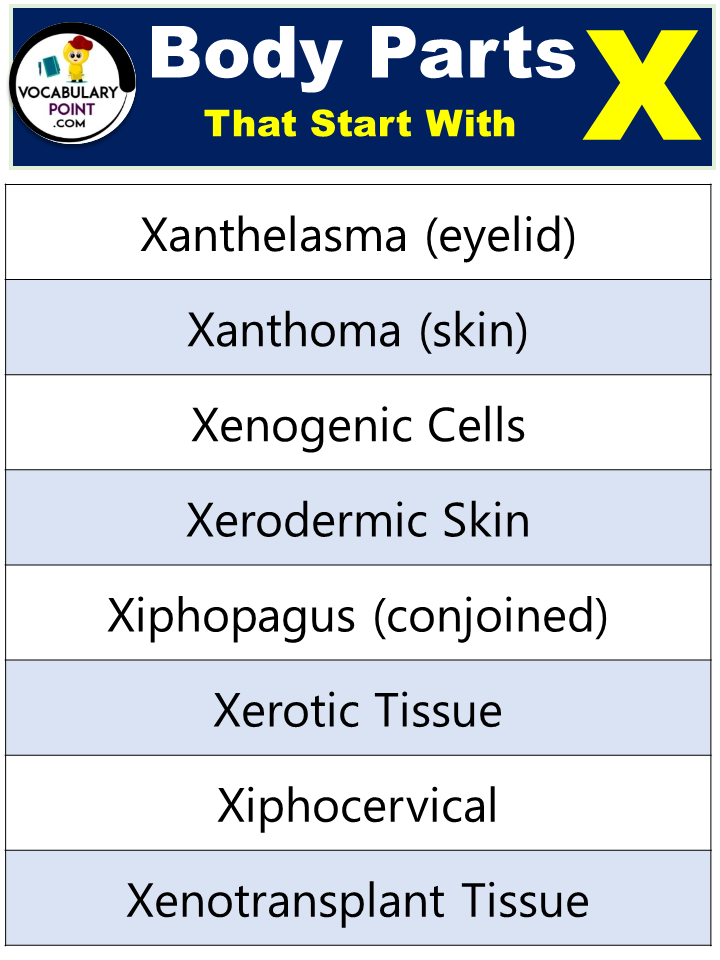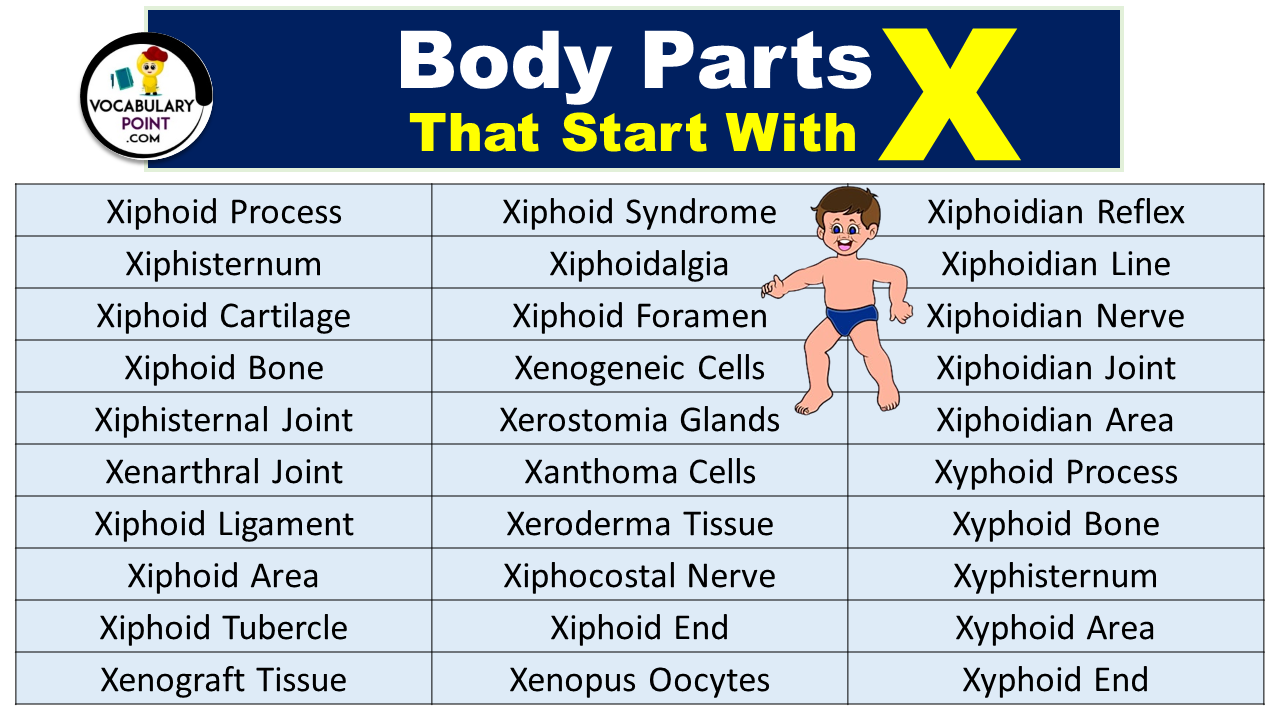Exploring the human body and its anatomy is a fascinating journey, particularly for beginners and students. One intriguing aspect is learning about body parts starting with different letters of the alphabet. Body parts that start with ‘X’, though not numerous, are unique in their structure and function.
This exploration provides an interesting challenge due to the rarity of anatomical terms starting with ‘X’. However, it’s a valuable exercise in understanding the diversity and complexity of human anatomy. Here, we present body parts that start with ‘X’, each with its distinct role and significance in the body.
Body Parts That Start With X
- Xiphoid Process
- Xiphisternum
- Xiphoid Cartilage
- Xiphoid Bone
- Xiphisternal Joint
- Xenarthral Joint
- Xiphocostal Junction
- Xiphoidian Muscle
- Xipho-umbilical Line
- Xiphoid Ligament
- Xiphopubic Muscle
- Xiphoid Area
- Xiphoid Tubercle
- Xenograft Tissue
- Xiphoid Syndrome
- Xiphoidalgia
- Xiphopagus Conjoined Twin
- Xiphoid Foramen
- Xiphoid Process Articulation
- Xeroderma Pigmentosum Cells
- Xiphoid Appendage
- Xiphopatellar Ligament
- Xenogeneic Cells
- Xerostomia Glands
- Xanthoma Cells
- Xanthelasma Palpebra
- Xeroderma Tissue
- Xiphocostal Nerve
- Xiphoid End
- Xenopus Oocytes
- Xiphoidian Reflex
- Xenobiotic Metabolizing Enzymes
- Xiphoidian Line
- Xiphoidian Process
- Xiphocostal Ligament
- Xiphocostal Muscle
- Xiphoidian Nerve
- Xiphoidian Joint
- Xiphoidian Cartilage
- Xiphoidian Area
- Xiphoidian Tubercle
- Xiphoidian Syndrome
- Xiphoidalgia Relief Points
- Xerophthalmia Glands
- Xiphocervical Junction
- Xenotransplant Tissue
- Xyphoid Process
- Xyphoid Cartilage
- Xyphoid Bone
- Xyphisternum
- Xyphoid Area
- Xyphoid Tubercle
- Xyphoid Ligament
- Xyphoidian Muscle
- Xyphoid Foramen
- Xyphoid Articulation
- Xyphoid Appendage
- Xyphopatellar Ligament
- Xyphoid End
- Xyphoidian Reflex
Explore More:
(A, B, C, D, E, F, G, H, I, J, K, L, M, N, O, P, Q, R, S, T, U, V, W, X, Y, Z)

Body Parts Beginning With X (And Their Properties)
- Xiphoid Process: A small, cartilaginous projection at the lower end of the sternum, serving as an anchorage for various muscles.
- Xiphisternal Joint: The articulation point where the xiphoid process fuses with the body of the sternum, usually ossifying in adult life.
- Xiphocostal Ligament: Connective tissue linking the xiphoid process to the costal cartilages, aiding in chest stability.
- Xiphopubic Muscle: A hypothetical or rare muscle extending between the xiphoid process and the pubic symphysis, mentioned in some anatomical variants.
- Xiphocentral Tendon: A theoretical or less-known tendon located near the xiphoid process, potentially involved in diaphragmatic movements.
- Xenogeneic Graft Tissue: Transplant tissue derived from a different species, often used in experimental and clinical settings.
- Xylophagous Tissue: Specialized tissue found in certain organisms that digest wood; not present in humans but a point of study in comparative anatomy.
- Xerotic Epidermis: Skin condition characterized by extreme dryness, often resulting in scaling or cracking.
- Xanthelasma Palpebrarum: Yellowish deposits of fat underneath the skin, often occurring on or around the eyelids.
- Xenoreceptors: Hypothetical or less-researched receptors in the body that might respond to foreign substances or xenobiotics.
- Xiphocostal Junction: The region where the xiphoid process and the costal cartilages come into proximity or articulate.
- Xiphopelvic Alignment: Refers to the alignment of the xiphoid process with the pelvic bones, relevant in certain anatomical studies or clinical assessments.
- Xanthoma Cells: Cells found in xanthomas, which are skin lesions caused by the accumulation of fat.
- Xerophthalmia: A medical condition characterized by dry eyes, often caused by a vitamin A deficiency.
- Xiphocervical Area: The anatomical region pertaining to the neck and the lower part of the sternum.
- Xiphoidalgia: Pain localized to the xiphoid process area, often due to trauma or inflammation.
- Xerodermic Skin: Skin that is excessively dry, often prone to irritation and scaling.
- Xiphisternal Synchondrosis: The cartilaginous joint between the xiphoid process and the sternum, prominent in younger individuals.
- Xiphoid Tubercle: A small, nodular extension on the xiphoid process, variably present in different individuals.
- Xenobiotic Metabolizing Cells: Cells in the body responsible for breaking down foreign chemical substances.
- Xiphocostal Angle: The angle formed at the point where the xiphoid process and the costal cartilages meet.
- Xiphopagus Formation: Referring to a type of conjoined twins united at the xiphoid process region.
- Xerotic Mucosa: Mucosal tissues that are abnormally dry, potentially leading to discomfort and respiratory issues.
- Xenotransplanted Organs: Organs transplanted from one species to another, not typical in humans but a topic of medical research.
- Xanthoderma: A condition characterized by yellowish discoloration of the skin, often related to dietary or metabolic issues.
- Xiphoid Echogenicity: Refers to the ultrasound appearance of the xiphoid process, important in diagnostic imaging.
- Xiphocostal Syndrome: A rare syndrome involving pain and discomfort in the xiphocostal region, possibly due to trauma or repetitive strain.
- Xiphoidectomy: Surgical removal of the xiphoid process, occasionally performed for therapeutic reasons.
- Xenogenic Cells: Cells derived from another species, used in scientific research and some therapeutic applications.
- Xiphisternal Dislocation: A rare dislocation of the xiphisternal joint, typically resulting from trauma.
Other Body Parts Names Starting With The Letter X
- Xiphisternum
- Xiphoid
- Xanthelasma (eyelid)
- Xanthoma (skin)
- Xiphocostal
- Xiphopubic
- Xyphoid
- Xenogenic Cells
- Xiphoidal
- Xerodermic Skin
- Xiphopagus (conjoined)
- Xerotic Tissue
- Xiphocervical
- Xenotransplant Tissue
- Xyphoid Ligament
- Xerophthalmic Tissue
- Xiphocostal Muscle
- Xanthoderma (skin)
- Xenogeneic Bone
- Xenobiotic Metabolizing Cells
- Xiphopelvic Alignment
- Xiphocentral Tendon
- Xenoreceptors
- Xiphocostal Junction
- Xiphopelvic Muscle
- Xiphisternal Synchondrosis
- Xiphoid Tubercle
- Xiphoidalgia
- Xiphoidectomy
- Xiphisternal Dislocation
